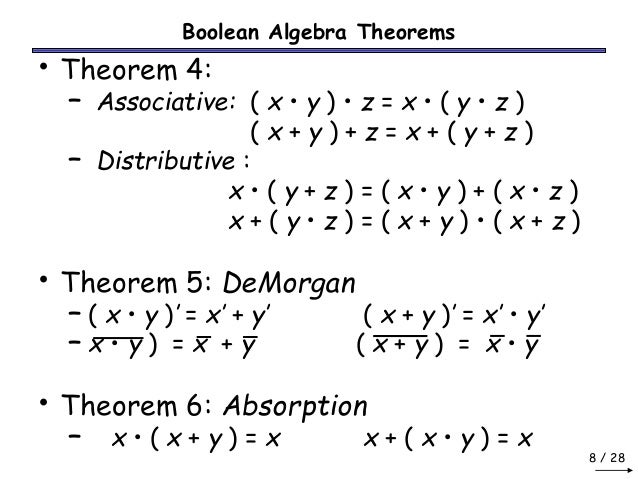Chapter
2
Boolean Algebra And Logic Gate
Boolean Algebra like any other mathematical system can be
defined with a set of elements, a set of operator and a no of unproved
postulates. This algebra in two valued system can be used to represent the
properties of bistable circuit.
Two Valued Boolean Algebra
It is defines on a set of two elements B= {0,1} with
rules for the two binary operators as following:
x
|
y
|
x+y
|
0
|
0
|
0
|
0
|
1
|
1
|
1
|
0
|
1
|
1
|
1
|
1
|
x
|
y
|
x.y
|
0
|
0
|
0
|
0
|
1
|
0
|
1
|
0
|
0
|
1
|
1
|
1
|
Basic
Postulates
These postulates are used to prove various Boolean
theorems and do not need any proof:
POSTULATES:-
1) x+0=
x
2) x.1=x
3) x+x’=1
4) x.x’=0
5) x(y+z)=xy+xz
6) x+y+z=(x+y)(x+z)
7) x+y=y+x
8) x.y=y.x
Basic theorems
The above listed postulates are used to prov some basic
theorems. The theorems are listed as following:-
Theorem 1
a)
x+x= x
(x+x)= (x+x)(x+x’)= x+x.x’= x
b)
x.x= x
x.x= x.x+0= x.x+x.x’= x (x+x’)
= x
Theorem 2
a)
x+1=1
x+1= (x+1).1= (x+1)(x+x’)=
x+x’=1
b)
x.0=0 (by the duality of a)
Theorem 3
(x’)’=x
(INVOLUTION)
Proof:
performing complement of variables two times preserving the same original
value.
Theorem 4
a)
x+xy=x (absorption)
x+xy= x (1+y) = x.1= x
b)
x(x+y)=x
x(x+y) = x.x+x.y= x+xy= x (1+Y)
= x
De Morgan’s Theorem
De Morgan’s Theorem
1)
(x+y)’=(x’.y’)
2)
(x.y)’=(x’+y’)
The validity of the de Morgan’s theorem is proved by
using truth table.
x
|
y
|
x+y
|
(x+y)’
|
x’
|
y’
|
x’+y’
|
0
|
0
|
0
|
1
|
1
|
1
|
1
|
0
|
1
|
1
|
0
|
1
|
0
|
0
|
1
|
0
|
1
|
0
|
0
|
1
|
0
|
1
|
1
|
1
|
0
|
0
|
0
|
0
|
Both columns are same. Hence
verified
|
x
|
y
|
x.y
|
(x.y)’
|
x’
|
y’
|
x’+y’
|
|
0
|
0
|
0
|
1
|
0
|
1
|
1
|
|
0
|
1
|
0
|
1
|
0
|
0
|
1
|
|
1
|
0
|
0
|
1
|
1
|
1
|
1
|
|
1
|
1
|
1
|
0
|
1
|
0
|
0
|
Both columns are same. Hence
verified
Use of De Morgan’s
theorem
It is used to realize a NORing operation with the use of
only AND gates and NOT gates and similarly NANDing operation by using only OR
gates can also be achieved.












0 comments:
Post a Comment